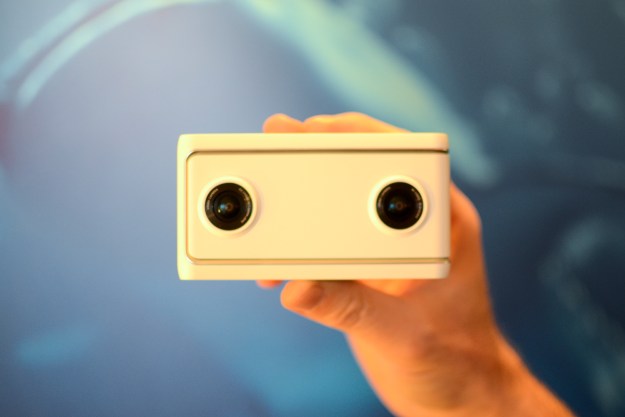
“The Lenovo Mirage Camera’s compelling 180-degree VR video live-streaming may make it a family favorite.”
- Very easy to use
- Live streaming wide-angle video is fun
- Viewing in VR is immersive
- Lightweight and compact
- We haven’t see final image quality yet
- Niche appeal
Lenovo isn’t a name that’s synonymous with cameras, but to increase the appeal of its new Mirage Solo stand-alone virtual reality headset, it has created its first one — the Mirage Camera. It’s not a single-lens point-and-shoot, or a pro-standard VR cam. It’s a dual-lens wide-angle camera suitable for everyone who wants to create immersive, fun to view stills and live video, all primarily designed for viewing through a VR headset.
Updated on May 4, 2018: Lenovo officially announced pricing and availability for the Mirage Camera. It is sold on Lenovo’s website, priced at $300. We have updated our hands-on review with some additional info. While the camera hasn’t changed much since we last played with it at CES 2018, we are currently reviewing the camera, in addition to Google’s VR180 app, for a full review.
The two 13-megapixel camera lenses take a 180-degree still photo — using Google’s VR180 format — or shoot 4K, 1440p, and 1080p resolution video. The advantages here are not having to think about composition, or where you place the camera. You can just point it in one direction, shoot, and the resulting image will pack in everything you see. There’s no viewfinder, so if you want to compose your shot, or make sure you’re getting everything in the picture, you’ll have to turn to the Mirage app on your phone. That’s not really the idea, though — this is for scale and simplicity, not works of art.
There are three camera modes — still photos, video, or live video streaming. We got a demonstration of how the video would look, as Lenovo wanted to highlight the camera’s versatility. In the demo, we were “attending” a kids birthday party, which had been shot on the Mirage Camera so we could view it on the Mirage Solo headset. We were watching everything going on around us, and it really did feel like we were there, especially when people made eye contact or talked to the camera. There’s considerable potential as a live coverage device here.
A dual-lens wide-angle camera suitable for everyone
The video VR experience was enhanced by the excellent image quality. The video was sharp, very colorful, and extremely pleasurable to watch. We were informed that the test video had been shot using a development version of the camera’s software, which wasn’t installed on the one we had in our hands. The samples we shot with this Mirage Camera during the demo were not up to the same high standard. Lenovo informed us the final version will be much more like the pre-prepared video footage. It doesn’t support the Mirage Solo’s six degrees of freedom, where you can move around in the real world and the virtual world, like the HTC Vive.
Operation is simple. There is an on/off button on the top of the camera, along with a mode selector and a shutter release. It was fast, and the lack of complex controls make it suitable for everyone to use. The one thing to remember when holding it is to keep your fingers out of the way, because the wide-angle lens easily picks them up in your shot. Behind a fold-out door on the side is a MicroSD card slot that adds up to 128GB of space to the built-in 16GB, plus a Type-C USB charging port. On the base of the camera is a tripod mount — a very welcome addition.
Photos are synced to the accompanying app and ideally uploaded to Google Photos, where they’re easily viewed on the Mirage Solo headset, or any other Daydream VR headset. The app is relatively basic, giving previews of your images and video alongside the live viewfinder modes. Instead of a plain background, the 180-degree images had a patterned background, almost like wallpaper, making the transition between your photo and the rest of the 180-degree image less jarring. We’re hoping Lenovo will include this in the app, as well as allow the effect to be customized. It’d be great to have a generic beach, forest, or cityscape to add to our photos, for example.
Although the live-streaming video aspect is the most compelling use for the Mirage Camera — potentially relegating it to something used at home or only indoors — Lenovo envisions the camera being carried around. It’s certainly light and compact enough, and provided the final image quality is as per the test videos, then it would be a welcome companion. However, there’s not much room for creativity shooting such wide angle pictures. You just point the camera in front of you. It certainly couldn’t replace your smartphone, or DSLR.
There’s also still only emerging interest in 180-degree images, and using a VR headset to view them. It’s by far the best way to do so, but it’s still a barrier for many people. The Mirage Camera and the Mirage Solo (or other compatible VR headset) go hand in hand together. If you’re not into VR, then a panoramic image taken with your phone may suffice should the situation arise.
That said, if you want to get involved with more immersive, higher-quality 180-degree images, but don’t think you’ll have the need for, or desire to learn how to use, a 360-degree camera , this is a convenient and extremely user-friendly way to do so. Lenovo will release the Mirage Camera on May 4, 2018, with a price of $300.










